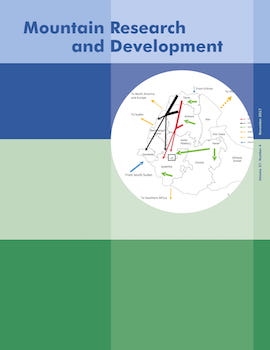The research field of socio-hydrology emerged recently as an attempt to better understand the interactions and feedback loops within water management systems (Sivapalan et al 2012). While acknowledging that the human impact on natural processes has reached unprecedented levels—a period now often termed the “Anthropocene”—the socio-hydrological perspective sheds light on the integrated character of water geographies and its implications for water supply and management. Departing from a critical perspective of political ecology, the hybrid nature of human–water relations has also been explored under the umbrella of waterscapes. In these studies, the importance of biophysical forces is recognized, but greater emphasis is placed on the role of politics and culture in shaping them (Swyngedouw 1999). This perspective, which has a stronger constructivist angle, is also evident in research dealing with the hydrosocial cycle, with a number of regional examples from the Andes of Chile (Boelens 2014; Linton and Budds 2014; Prieto 2015; Usón et al 2017). Despite critical commentary (Sivakumar 2012), the socio-hydrological perspective provides for a comprehensive understanding of water systems and aims at solution-oriented recommendations (Di Baldassarre et al 2013, 2015; Sivapalan 2015; Pande and Savenije 2016; Pande and Sivapalan 2016). Thus, socio-hydrology offers novel entry points for a more fertile engagement between the natural and social sciences across different scales ranging from the plot level to entire watersheds. Its interdisciplinary nature encompasses (and integrates) various methodological approaches: from the air (remote sensing), on the ground (empirical field studies), and in the laboratory (modeling).
Even though the coevolution of hydrological and social processes has existed since ancient times, little attention has been paid to the nexus of human–water relations and its applicability under diverse conditions. It was only in 2012 that the term “socio-hydrology” was coined, almost simultaneously, in 2 independently authored papers (Nüsser et al 2012; Sivapalan et al 2012). Since then various reviews and papers have explored the usefulness and applicability of conceptual approaches within this research field (Blair and Buytaert 2016; Wesselink et al 2016). The growing interest in concepts of socio-hydrology reflects its validity as a lens with which to identify problems and find solutions toward critical human–water relations (Figure 1).
FIGURE 1
Number of peer-reviewed publications with the term “socio-hydrology” between 2012 and 2017. (Source: Web of Science, data collection: 20 September 2017)

Mountain regions are characterized by dynamic water-related processes and associated risks, and they are important water towers that serve the demands of huge populations both in uplands and adjoining lowlands (Viviroli et al 2007). These regions are renowned for their diverse range of environmental and social variables—which lead to highly site-specific particularities. The integrated perspective of socio-hydrology provides a flexible and nuanced way to deal with a multitude of water-related issues across various scales. Examples of coupled systems most prominent in mountain environments include glacier changes, flood dynamics, and irrigation networks (Nüsser et al 2012; Carey et al 2017) as well as mining activities and water quality (Rojas and Vandecasteele 2007; Huang et al 2010) to name but a few. These advances in understanding waterscapes in mountain regions have also been a focus of several papers published in this journal (MRD). Though these papers have not explicitly used a socio-hydrological conceptual framework, they do employ an integrated perspective in analyzing critical human–water relations (Paerregaard 2013; Prieto 2015; Ali et al 2017).
One specific example is the case of glacier-fed irrigation networks in the semiarid western Himalayan and Karakoram ranges (Kreutzmann 2011). Here, socio-hydrological interactions are highly spatially and temporally dynamic, having been shaped by the interplay of (glacio-)fluvial runoff, water distribution mechanisms, socioeconomic conditions, and external development interventions. Case studies in relatively close spatial proximity within these mountain ranges (from the Hunza Karakoram and the Nanga Parbat region) reveal singularly unique adaptation strategies to cope with variations in water supply and risks associated with glacier lake outburst floods (Parveen et al 2015; Nüsser and Schmidt 2017).
Another small-scale study, this time from the Trans-Himalaya of Ladakh, India, focuses on the innovative so-called “artificial glaciers,” which are cascading ice storage dams introduced in several tributaries of Indus River. These artificial structures, located at altitudes below the glaciers and above agricultural settlements, seek to minimize the risk of water scarcity for smallholder irrigation. Such ice storage dams utilize the physical process of icing to facilitate the freezing of stream water during the winter to be later released as meltwater in the critical growing period in spring (Clouse et al 2016; Nüsser and Baghel 2016).
The construction of dams for hydroelectricity, flood protection, and irrigation continues apace in almost all mountain regions and has led to a massive transformation of river systems and significant socioeconomic outcomes. Such large projects represent the results of complex and competing actor interests as well as feats of engineering that seek to control and harness nature through the fragmentation of fluvial environments. The socio-hydrological nature of dam building under diverse socioeconomic, political, and technological settings becomes apparent through the implementation of new water and energy governance (Erlewein and Nüsser 2011; Nüsser and Baghel 2017).
The analyses of these site-specific human–water systems benefit from a socio-hydrological perspective, which is not a set of static predetermined steps and methods but a flexible concept that better engages with the fluid and complex interactions of waterscapes at various scales. In addition to providing a sound conceptual lens for human–water research, this approach has great potential for informing policy frameworks within the context of mountain development and adaptation strategies to global environmental change in mountain regions and beyond. With its broad perspective, promoting systems, targets, and transformation knowledge for sustainable development, MRD is an ideal platform to foster socio-hydrological research. Therefore, it is hoped that more contributions adopting the socio-hydrological lens will be submitted to this journal.





